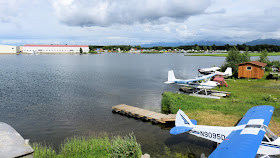Situated on the edge of the world's busiest seaplane base, Lake Hood, the Alaska Aviation Museum is right in the heart of aviation activity in Anchorage, Alaska. After our glacier tour with Rust's, we explored this monument to Alaskan aviation history.
Spoiler alert: there may have been some seaplanes.
Hanging above the entrance hall is this 1929 Travel Air S6000. It operated in Alaska as a passenger and cargo hauler starting in 1939.
I was particularly taken with this gorgeous 1934 WACO YKC on floats.
A key character in early Alaskan aviation was Noel Wien who founded Wien Air Alaska, Alaska's first airline. This fuselage, which strongly resembles some of the Stout designs that led to the Ford Trimotor, is from a Hamilton Metalplane. The type was flown by Noel Wien on the first round trip between North America and Asia, the first American flight into Soviet Russia, and the first aerial crossing of the Bering Sea.
The Bear hopped in this...um...thing...to conduct an imaginary flight.
Hey there, little miss, eyes on the sky! And wipe that smile off your face! Flying is serious business, dammit!
Here's a rare one: a Szekely SR-3 three cylinder radial engine built in Holland, MI. They were not exactly renowned for reliability, which is probably why I had never heard of Szekely engines until I found one in Alaska.
The oldest aircraft in the collection is this 1928 Stearman C2B. I confess that I did not recognize it as a Stearman at first because it lacked the distinctive gear legs of the later (1934) Stearman Kaydet. In 1932, it was involved in the first landing and rescue on Denali.
This engine is from the recovered wreck of Alaskan aviation pioneer Steve Mills, who crashed his Bellanca Pacemaker while flying a fishing charter in 1936. It serves as a reminder that the tremendous advantages conferred to Alaska by aviation came at a high price for early pioneers in flight.
Goofy interlude with The Bear! Now, back to the aircraft.
This 1941 Stinson L-1 Vigilant served as an observation aircraft during WWII and operated from Fairbanks and Anchorage. Though the museum claims that it is the only surviving example of the approximately 400 L-1s built, there appear to be a small handful of them scattered around the United States.
What is particularly unique about this liaison aircraft, which differentiates it from Stinson's far more common L-5 Sentinel, is the outward cant of its windows to facilitate ground observation.
The Bear came in hot and greased the landing on Runway 8.
This 1974 F-15 Eagle served at Elmendorf Air Base in Anchorage before it came to museum.
Grumman made a series of twin-engined, amphibious flying boats of different sizes with the smallest being the Widgeon. The history of this 1943 Widgeon is not well known.
This is a Boeing 737 known as a Combi or Mud Hen, built as a combination passenger and cargo ship for maximum versatility. It flew for Alaska Airlines from 1981 to 2007. It is normally open to museum visitors, but was closed up because of a rainstorm that morning.
The Bear was intrigued by this 1955 Piper Super Cub. Here she is looking "super" with the Super Cub.
Maybe it's time to land when your passengers look like they were inspired by Edvard Munch?
Seaplane trainer?
The Goose was the next larger amphibian built by Grumman in the 1940s. This was the same type of aircraft featured in Tales of the Gold Monkey, an ABC adventure series that aired from 1982 to 1983. I loved that show, but no else seems to remember it (which probably explains why only a single season was ever made). This Goose started its service with the Navy in 1944, transitioned to the U.S. Fish & Wildlife Service in Alaska in 1956, then was reassigned to the Department of the Interior from 1974 until 1994. This airplane performed public service in Alaska for an astounding 38 years.
This is the wreckage of the Douglas World Cruiser Seattle, built for a US Army project to circumnavigate the globe by air. Four airplanes, the Seattle, Boston, Chicago, and New Orleans departed on their journey in April 1924 from Seattle, Washington. The Seattle, the lead ship, crashed in Alaska 24 days later. Pictured here are the remains of the propeller and the aircraft's Liberty L-12 engine. The Boston crashed in the Atlantic and was never recovered. A prototype World Cruiser, rechristened the Boston II, joined the Chicago and the New Orleans to complete the flight by returning to Seattle in September after 371 hours in flight.
A beautiful 1944 Stinson Reliant.
A Beech 18 on floats!
This 1944 Beech 18 is displayed as configured during its time as a Search and Rescue aircraft at Elmendorf AFB in Anchorage.
This 1943 Consolidated PBY Catalina is truly a magnificent wreck of an aircraft.
When we were finished touring the museum, we lingered on the grounds to absorb the activity at Lake Hood Seaplane Base.
We even caught one of Rust's Beavers departing the water.
The Alaska Aviation Museum has some interesting, unique aviation artifacts and great stories to tell about aviation in The Last Frontier.




































No comments:
Post a Comment